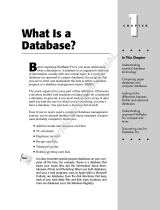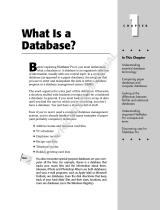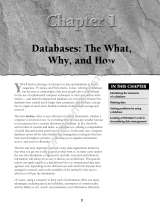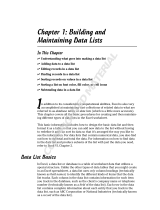
Chapter 1: FileMaker Pro basics
You’re using FileMaker Pro software because you have information to
manage, or information you would like to publish on the World Wide
Web. This information could be just about anything: accounts,
inventories, suppliers, sales contacts, employees, or products. The
power, flexibility, and ease of use of FileMaker Pro help you manage
that information, so you can:
1 find information quickly
1 update and maintain information
1 print documents like invoices, form letters, and mailing labels
1 analyze information using onscreen and printed reports
Important Before you read this chapter, be sure you know how to use
FileMaker Pro Help, as explained in the preface, “Getting help.”
Understanding FileMaker Pro
Before you begin to work with FileMaker Pro, you should be familiar
with the basics of FileMaker Pro. If you’re new to databases, start with
the next section, “What’s a database?” If you’re familiar with databases
but new to FileMaker Pro, start with “What’s a FileMaker Pro database
file?” on page 1-4.
What’s a database?
A database is a collection of information, or data, that you can organize,
update, sort, search through, and print as needed. A database doesn’t just
hold information—you use a database to organize and analyze
information so that you understand its significance.
A database can be one file, such as Clients, which might hold the names,
addresses, and phone and fax numbers of all your clients.
A database can also be many files that, together, contain all the
information about a particular topic, or related topics (sometimes called
a database system). For example, a database for a travel agency can
include files that hold information about clients, tours, invoices,
and accounting.



























